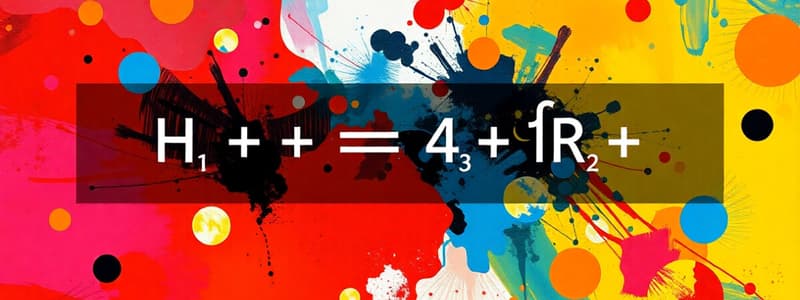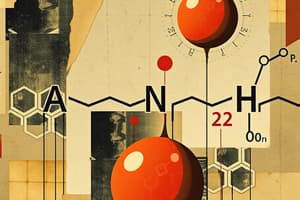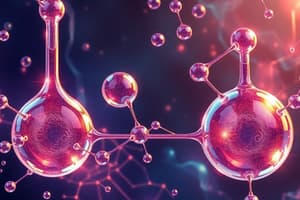Podcast
Questions and Answers
According to Markovnikov's Rule, when adding HX to an asymmetric alkene, which product is favored?
According to Markovnikov's Rule, when adding HX to an asymmetric alkene, which product is favored?
- Two equal products with symmetrical carbons
- The product with the most substituted carbon (correct)
- No specific product is favored
- The product with the least substituted carbon
The addition reactions of alkenes are usually endothermic.
The addition reactions of alkenes are usually endothermic.
False (B)
What type of carbocation is formed when 1-bromopropane is produced from propene and HX?
What type of carbocation is formed when 1-bromopropane is produced from propene and HX?
secondary carbocation
In the reaction of CH₃CH₂CH=CH₂ with HX, the product CH₃CH₂CH-CH₃ demonstrates the concept of __________.
In the reaction of CH₃CH₂CH=CH₂ with HX, the product CH₃CH₂CH-CH₃ demonstrates the concept of __________.
Match the following alkene reactions with their respective descriptions:
Match the following alkene reactions with their respective descriptions:
Which of the following describes the condition under which Anti-Markovnikov's addition occurs?
Which of the following describes the condition under which Anti-Markovnikov's addition occurs?
Markovnikov's Rule states that during the addition of HX to an alkene, the hydrogen atom bonds to the carbon atom with the most hydrogen substitutes.
Markovnikov's Rule states that during the addition of HX to an alkene, the hydrogen atom bonds to the carbon atom with the most hydrogen substitutes.
What is produced when CH3-CH=CH2 reacts with HBr in the presence of peroxides?
What is produced when CH3-CH=CH2 reacts with HBr in the presence of peroxides?
The stable free radical formed during the anti-Markovnikov addition is indirectly attributed to __________.
The stable free radical formed during the anti-Markovnikov addition is indirectly attributed to __________.
Match the following reactions with their outcomes:
Match the following reactions with their outcomes:
Which of the following statements accurately describes Markovnikov's Rule in the context of electrophilic addition reactions?
Which of the following statements accurately describes Markovnikov's Rule in the context of electrophilic addition reactions?
In hydroboration, the addition is considered anti-Markovnikov.
In hydroboration, the addition is considered anti-Markovnikov.
What reagent is used for the anti-Markovnikov addition of hydroxyl groups to alkenes?
What reagent is used for the anti-Markovnikov addition of hydroxyl groups to alkenes?
The process of adding bromine or chlorine to alkenes typically results in the formation of ________ dihalides.
The process of adding bromine or chlorine to alkenes typically results in the formation of ________ dihalides.
Match the following reaction mechanisms to their characteristics:
Match the following reaction mechanisms to their characteristics:
Flashcards
Markovnikov's Rule
Markovnikov's Rule
When a hydrogen halide adds to an alkene, the hydrogen atom adds to the carbon with more hydrogens already attached.
Addition Reaction (Alkenes)
Addition Reaction (Alkenes)
A reaction where a molecule adds across a double bond in an alkene.
Carbocation Intermediate
Carbocation Intermediate
A positively charged carbon atom intermediate formed in the reaction of an alkene with an electrophile.
Symmetric alkene reaction
Symmetric alkene reaction
Signup and view all the flashcards
Asymmetric alkene reaction
Asymmetric alkene reaction
Signup and view all the flashcards
Anti-Markovnikov Addition
Anti-Markovnikov Addition
Signup and view all the flashcards
Free Radical Chain Mechanism (with peroxides)
Free Radical Chain Mechanism (with peroxides)
Signup and view all the flashcards
Chain Initiation (peroxide)
Chain Initiation (peroxide)
Signup and view all the flashcards
Chain Propagation (peroxide)
Chain Propagation (peroxide)
Signup and view all the flashcards
Oxymercuration Hydration
Oxymercuration Hydration
Signup and view all the flashcards
Harkonikov Addition
Harkonikov Addition
Signup and view all the flashcards
Hydroboration Hydration
Hydroboration Hydration
Signup and view all the flashcards
Electrophilic Addition of Br2/Cl2 to Alkenes
Electrophilic Addition of Br2/Cl2 to Alkenes
Signup and view all the flashcards
Identify the Major Product
Identify the Major Product
Signup and view all the flashcards
Study Notes
Addition Reactions
- Addition reactions involve the addition of atoms or groups to a molecule, typically across a double or triple bond.
- Attacking the pi bond on an electrophile often forms a carbocation
- Rich electron density is present on the C=C pi bond.
- Addition of hydrogen halides to alkenes results in carbocations
- Carbocation geometry is planar.
- Symmetrical alkenes give equal numbers of carbons around the double bond.
- Addition reactions proceed through secondary carbocations.
- Hyperconjugation and inductive effect influence carbocation stability.
- Reactions tend to be exothermic.
Markovnikov's Rule
- In electrophilic addition reactions on alkenes, the electrophile (e.g., H+) generally attaches to the carbon of the double bond that already has more hydrogen atoms.
- The product with the more highly substituted carbocation intermediate is favored.
- Reaction often proceeds slower in the less substituted intermediate.
- Constitutional isomers are formed, but one is predominantly formed (regioselectivity).
Exceptions to Markovnikov's Rule
- Peroxide effect: Peroxides favor the "anti-Markovnikov" addition of hydrogen halides.
- Free radical mechanisms bypass intermediate carbocations, leading to unexpected regiochemistry.
Acid-Catalyzed Hydration
- Addition of water to an alkene in the presence of an acid catalyst (e.g., sulfuric acid) results in the formation of an alcohol.
- A carbocation intermediate is formed.
- The reaction proceeds via a protonation step, carbocation formation, and finally nucleophilic attack by water.
- Tertiary carbocations are favored.
Mechanism of Addition Reactions (Examples)
- Various mechanisms for addition exist (e.g., ionic, free radical, anti-Markovnikov).
- Examples include addition of hydrogen halides, water, or halogens.
- Key steps involve bond breaking, formation of carbocation(s), and nucleophilic attacks.
- Acid-catalyzed hydration often leads to alcohol formation.
- Understanding the stability of carbocation intermediates is crucial for predicting the major products.
Thermodynamics of Addition/Elimination Reactions
- Thermodynamic factors affect the equilibrium of addition and elimination reactions
- Equilibrium position depends on temperature and product stability .
- Le Chatelier's principle can be used to predict how equilibrium will shift based on changing factors such as temperature.
- Consider entropy effect on reaction equilibrium.
Studying That Suits You
Use AI to generate personalized quizzes and flashcards to suit your learning preferences.




